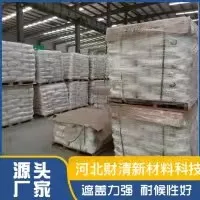
Aug . 08, 2025 13:45 Zurück zur Liste
The Protective Role of Titanium Dioxide Against UV Degradation in Plastics
The vulnerability of plastic materials to ultraviolet radiation presents a significant challenge for manufacturers across industries. When exposed to sunlight over extended periods, plastic polymers undergo photochemical reactions that lead to chain scission, cross-linking, and the formation of free radicals. These molecular changes manifest as visible signs of aging - yellowing, surface cracking, loss of mechanical strength, and overall deterioration of material properties. The severity of UV damage depends on multiple factors including polymer type, environmental conditions, and exposure duration.

Titanium Dioxide as a UV Stabilizer in Plastic Formulations
Titandioxid (TiO₂) has emerged as one of the most effective solutions for combating UV-induced plastic degradation. This versatile white pigment functions through multiple protective mechanisms when incorporated into plastic formulations. Primarily, TiO₂ acts as an efficient UV absorber, capturing harmful high-energy photons before they can initiate destructive photochemical reactions within the polymer matrix. The semiconductor properties of titanium dioxide powder enable it to absorb UV radiation across a broad spectrum, particularly in the critical UV-B range (280-315 nm) where sunlight is most damaging to organic materials. Beyond simple absorption, the light-scattering properties of TiO₂ rutile particles create an additional barrier effect, reflecting and diffusing incident UV radiation away from the plastic surface. This dual action of absorption and reflection makes titanium dioxide an exceptionally comprehensive UV protection system for plastic products.
Comparing Rutile and Anatase TiO₂ for UV Protection
The crystalline form of titanium dioxide significantly influences its performance in UV stabilization applications. Rutile titanium dioxide demonstrates superior protective qualities compared to its anatase counterpart for several fundamental reasons. The rutile crystal structure possesses a higher refractive index (2.7 versus 2.5 for anatase) and broader UV absorption spectrum, enabling more effective blocking of harmful radiation. More importantly, rutile TiO₂ exhibits significantly lower photocatalytic activity - a critical advantage since photocatalysis can actually accelerate polymer degradation. The surface chemistry of rutile titanium dioxide powder can be further optimized through specialized inorganic treatments that enhance dispersion in plastic matrices while minimizing any residual photocatalytic effects. In contrast, anatase TiO₂, while effective for certain applications requiring photocatalytic activity, generally proves less suitable for long-term outdoor plastic products due to its tendency to promote rather than prevent UV degradation under sustained exposure.
Mechanisms of UV Protection by Titanium Dioxide
The anti-UV aging performance of titanium dioxide in plastics operates through several synergistic mechanisms working at both macroscopic and molecular levels. At the surface level, TiO₂ particles create a protective barrier that reflects and scatters incoming UV radiation, reducing the amount of harmful energy penetrating into the plastic. On a molecular scale, the semiconductor properties of TiO₂ rutile enable it to absorb UV photons and dissipate the energy as heat through vibrational modes, preventing the formation of destructive free radicals. High-quality titanium dioxide powder from reputable suppliers undergoes surface treatments that optimize these protective mechanisms while ensuring excellent dispersion throughout the polymer matrix. Some advanced grades incorporate additional stabilizers that work in concert with TiO₂ to quench any free radicals that do form, providing comprehensive protection against all stages of the UV degradation process. This multi-layered defense system explains why properly formulated titanium dioxide-containing plastics maintain their properties and appearance even after years of outdoor exposure.
Optimizing TiO₂ Performance in Plastic Applications
Achieving maximum UV protection in plastic products requires careful consideration of titanium dioxide selection and incorporation parameters. The particle size distribution of titanium dioxide powder significantly affects its UV screening efficiency, with optimal performance typically achieved in the 200-300 nm range. Concentration levels must balance protection needs with other material properties - generally between 2-5% by weight for most outdoor plastic applications. Leading titanium dioxide powder suppliers offer specialized rutile grades featuring surface treatments specifically designed for plastic systems, improving dispersion and compatibility while minimizing any potential negative effects on polymer processing or mechanical properties. The method of incorporation also impacts performance, with masterbatch formulations often providing more uniform distribution than direct dry blending. Advanced composite systems may combine TiO₂ with other stabilizers like HALS (Hindered Amine Light Stabilizers) to create synergistic effects that surpass the protection offered by any single component. These formulation considerations become particularly critical for demanding applications such as automotive components, outdoor furniture, or construction materials where long-term weatherability is essential.
Future Developments in TiO₂ UV Protection Technology
The ongoing evolution of titanium dioxide technology promises even more effective solutions for plastic UV protection in coming years. Research focuses on developing next-generation rutile titanium dioxide powders with enhanced surface modifications that further reduce photocatalytic activity while improving dispersion stability. Some innovative approaches involve creating hybrid particles that combine TiO₂ with other UV-absorbing materials to extend protection into additional wavelength ranges. There is also growing interest in developing more sustainable titanium dioxide production methods that maintain or improve protective performance while reducing environmental impact. As plastic applications continue to expand into more demanding environments, from extreme climates to high-UV geographical regions, titanium dioxide powder suppliers are responding with increasingly sophisticated solutions. These advancements will enable plastic products to meet ever-higher durability expectations while addressing growing regulatory requirements and sustainability concerns in the materials industry. The fundamental UV-protective properties of titanium dioxide ensure it will remain a cornerstone of plastic stabilization technology, even as specific formulations and applications continue to evolve.
Dies ist der letzte Artikel
-
The Protective Role of Titanium Dioxide Against UV Degradation in Plastics
NachrichtAug.08,2025
-
How to Choose the Right Grade of Rutile Titanium Dioxide
NachrichtAug.08,2025
-
Why Rutile Titanium Dioxide Is Preferred in Plastic Manufacturing
NachrichtJul.21,2025
-
Why High-Quality Printing Paper Cannot Do Without Titanium Dioxide
NachrichtJul.21,2025
-
Why Exterior Wall Coatings Prefer Rutile Titanium Dioxide
NachrichtJul.21,2025
-
Optical Properties and Light Interaction of Titanium Dioxide
NachrichtJul.21,2025
